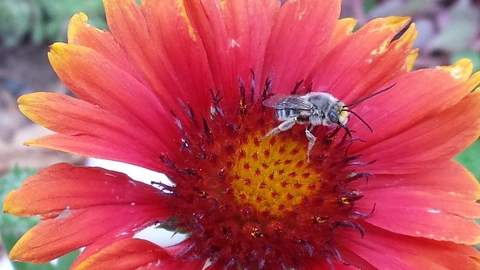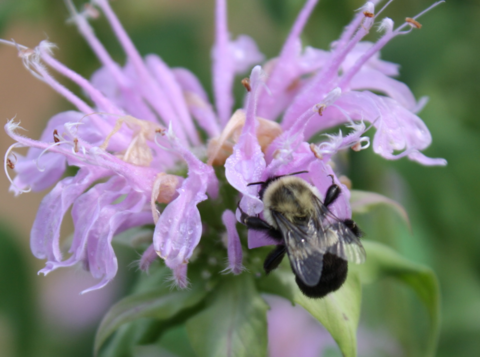Sign up to be notified of this and other volunteer opportunities with native bees.
Minnesota Bee Atlas
What is the Minnesota Bee Atlas?
The Minnesota Bee Atlas is a research project that relies on volunteers to learn more about the distribution and diversity of native bees in Minnesota.
Volunteer observations, combined with historical records from the Minnesota Department of Natural Resources and the University of Minnesota insect collection, provide important information on which bees live here and where they can be found.
Volunteers have documented over 25,000 bees in Minnesota. They submit photos of bees to iNaturalist, adopt roadside survey routes to capture, identify and release bumble bees, and monitor nesting blocks for stem-nesting bees.
Data from the Bee Atlas is available as a part of the Minnesota Biodiversity Atlas.
Get involved
The current work of the Bee Atlas uses DNA analysis to identify the plants used by leaf-cutter and resin bees to construct their nests. Volunteers are needed to host and observe stem nests from April to October.
You still can share your photos of bees on iNaturalist. You don’t have to be a bee expert. Just upload your photo with an accurate date and location and other users will help you identify what you have seen.
The second phase of the MN Bee Atlas will focus on the plants that tunnel-nesting bees use to build their nests, while continuing to learn about distributions, phenology, and habitat associations. Many tunnel-nesting bees use leaf pieces, chewed leaves, plant resins, or plant hairs to line and cap the nests where their offspring will develop and over-winter. The Bee Atlas will use DNA and resin analysis to identify which plants the bees are using so that we can understand this important part of their habitat needs.
We distributed nesting blocks to volunteers in spring 2022, to be placed in areas such as county parks, nature centers, and DNR Scientific and Natural Areas (SNAs) across the state. Bees will nest in these blocks, and volunteers will observe the blocks to see when bees are most active and what they build their nests out of. When blocks are returned to our lab in the fall, Bee Atlas staff will take samples of nesting material for analysis and rear larvae from the nests to adulthood for identification.
If you have questions about what you see at your block, you may contact beeatlas@umn.edu or post a comment on our Facebook page. Please keep in mind that it will be easiest for us to answer your question if you are able to include a photo.
Contact beeatlas@umn.edu for more information about volunteering.
Using your own nesting blocks
If you are interested in putting up a bee block in your yard to observe and host tunnel-nesting bees, there are many companies offering pre-made bee houses as well as directions to build your own. We like the suggestions offered by Joel Gardner, in “Native Bees, Solitary Bees, and Wild Bees: What are they?” and the Xerces Society's “Providing nest sites for pollinators”.
Although we are limited in the number of larvae we can rear and cannot accept additional blocks, we welcome observations of your backyard bee nests. If you see bees using your bee house you can submit pictures to the MN Bee Atlas iNaturalist project the same way you would for anecdotal observations.
You can also help us learn about the plants that bees are using by taking pictures of the cuts that leaf-cutter bees make in plant leaves and uploading them to the Megachile Bee Leaf Cuts iNaturalist project. To submit observations, you will first need to create an account on iNaturalist. After you have created an account, click on “Projects” at the top of the page and search for “Megachile Bee Leaf Cuts” to submit your observations.
Although you may not notice each one, chances are that you cross paths with several different bee species on a regular basis. Some may be smaller than you expect and many look quite different than the honey or bumble bees that most of us are used to. Colors can range from metallic greens and blues to combinations of yellow, white, black, and red, but most bees are covered in hairs that make them look fuzzy. If you see an insect with pollen stuck in the hairs on her legs or abdomen, you are looking at a bee.
To submit observations of bees you see when you are out and about, you will first need to create an account on iNaturalist. After you have created an account, click on “Projects” at the top of the page and search for “Minnesota Bee Atlas” to submit your observations. Do not worry if you do not know the species of bee, just fill in as much information as you can. Other volunteers may be able to identify the bee based on your photo.
For the greatest chance of using your photo to identify the bee species, please submit clear photos that are in color. Photographing the bee from different angles often helps reviewers. You may also want to boost the number of bees you may find in your yard by providing nectar and nesting habitat.
Bumble bee surveys continue. Bee Atlas volunteers and the Xerces Society catch and release bumble bees to survey them throughout Minnesota. Learn more at the Minnesota Bumble Bee Atlas.
Photographs of bumble bees you see while camping, hiking, walking the dog, etc. can be submitted to the Xerces Society’s Bumble Bee Watch project. See recommendations in Anecdotal observations regarding bee photography. Minnesota records from Bumble Bee Watch will be integrated into the Minnesota Bee Atlas.
Volunteer
Funding for this project is provided by the Minnesota Environment and Natural Resources Trust Fund as recommended by the Legislative-Citizen Commission on Minnesota Resources (LCCMR).



